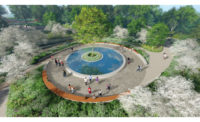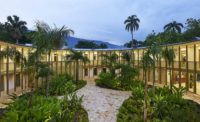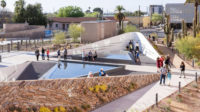Which individuals and groups deserve public memorials isn’t always clear. But there is no question that the 20 first graders and six educators shot to death by a lone teenager in Sandy Hook, Connecticut, on December 14, 2012, were owed a public marker. A crackpot has spent years calling the massacre a hoax and the bereaved parents liars. The memorial that opened this week in the town of 29,000 is a rebuke written in stone. “By building a memorial we are saying this happened, it’s the truth,” says Dan Affleck, one of its two designers.
The scores of Sandy Hook citizens involved in the 10-year process of choosing a memorial did their jobs well. They visited 17 sites before settling on a wooded hollow a few hundred yards from the old Sandy Hook School (which was demolished and replaced in 2016), then selected just the right design from among 188 entries in a 2017 competition. The plan by Affleck and Ben Waldo, two young landscape architects, is modest but substantial, geometrically precise yet seemingly at home in its natural surroundings. “It’s not a monument; it’s a landscape,” Waldo says. That landscape is focused on a donut-shaped granite pool, with an overall diameter of 47 feet, its outer wall bearing the names of the victims, its inner wall girdling a patch of earth on which a single tree (a hearty hybrid of sycamore and London plane) grows bravely. Thirty-nine hidden pumps keep the water moving counterclockwise through the shallow pool, symbolizing the continuity of life, perhaps, while also providing soothing sights and sounds. From the pavement encircling the pool, paths extend into the surrounding meadow, offering places for contemplation. The $3.7 million memorial occupies about 3.5 acres of the 5.5-acre site. That’s somewhat less than the designers had originally proposed, but otherwise the memorial as built is little changed from their initial submission.

1

2
The outer wall of the memorial's pool bears the names of the massacre's victims. Photo by David Lloyd
Affleck and Waldo were colleagues at the San Francisco office of the large landscape architecture firm SWA when they teamed up to enter the competition. In 2018, when they were named finalists, they brought the project to the firm (where both still work). They also brought in a Connecticut partner, Tara Vincenta of Artemis Landscape Architects, in part because of her knowledge of local biomes and in part to ensure that a local practitioner would be available to the families. (Other consultants include Fluidity Design, the California-based water feature experts.) After funding was approved by the town in April 2021, the team completed construction documents in just five weeks. Ground was broken last August. The idea was to unveil the memorial by the tenth anniversary of the shootings, on December 14. In fact, a private dedication ceremony was held there last week; wreaths placed by survivors circulated in the pool. And now, with almost no publicity, the memorial has begun to draw a steady stream of visitors.
In November the plantings those visitors encountered were a bit sparse, but the tree in the middle of the fountain seemed to be retaining its foliage longer than any other tree in sight—perhaps the beneficiary of a microclimate created by the water swirling around it.
Affleck and Waldo say they plan to return several times a year, to watch the landscape mature. Could the country, in its attitude toward guns, mature as well?









Post a comment to this article
Report Abusive Comment